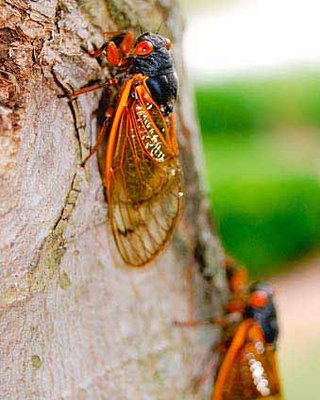Rise From The Grave
For those living on the East Coast of the United States, you have been warned. Sometime between mid-April to late May, millions of creatures will be invading your communities and homes. Yes, that’s right.
MILLIONS.
The Brood II cicadas, Magicicada sp, are periodical cicadas that feed underground on root xylem fluids as nymphs for 17 years before emerging to mate, lay eggs, and die, within the same few weeks of emergence. This means that these periodical cicadas are only above ground level for 4-6 weeks once every 17 years!
“What will happen is the nymphs will come up and they will shed their nymphal skin and they’ll crawl up into the trees and they’ll take about five days to harden and then they’ll start for next four to six weeks calling and looking for mates,” said Craig Gibbs, an entomologist at the Wildlife Conservation Society’s Queens Zoo. (CBS News, 2013) There are roughly around 1500 species of cicadas in the world, however these Magicicada sp are known to be the only periodical species around.
This is particularly interesting because of their prime-numbered life cycle and the amazing periodic, synchronized appearance in extremely large numbers. (Williams, K., Smith, K., & Stephen, F.,1993) One theory predicts that the synchronized appearance of periodical cicadas may be a classical example of predator satiation. (Williams , K., & Simon, C., 1995) This happens when the very first cicadas to emerge suffer heavy predation, but that predators become satiated within a matter of days. By the time predators foraging activities increased, the density of adult cicadas was waning. As a result, this periodical, synchronized life cycle of Magicicada sp are long enough to escape the delayed density-dependent effects of predators. Pretty smart for such a small insect, don’t you think?

“Noisy cicadas can call big catfish to the top,” by Kevin Tate. Northeast Mississippi Daily Journal.
These creatures live underground for 17 years, before emerging just to have sex and die. I’m never complaining about my life ever again.
Academic/Website Sources:
Williams , K., & Simon, C. (1995). THE ECOLOGY, BEHAVIOR, AND EVOLUTION OF PERIODICAL CICADAS. Annual Review of Entomology , 40: 269-95.
Williams, K., Smith, K., & Stephen, F. (1993). Emergence of 13-Yr Periodical Cicadas (Cicadidae: Magicicada): Phenology, Mortality, and Predators Satiation. Journal of Ecology , 74(3): 1143-1152.
“Noisy cicadas come back to life after years underground,” by CBS News. CBS Interactive Inc, 6 April 2013. URL: http://www.cbsnews.com/8301-33816_162-57578257/noisy-cicadas-come-back-to-life-after-years-underground/?utm_medium=twitter&utm_source=twitterfeed (accessed on 5 April 2013)
Video Source:
“Amazing Cicada life cycle – Sir David Attenborough’s Life in the Undergrowth – BBC Wildlife,” by BBC. BBC Worldwide Youtube Channel, 24 October 2008. URL: http://www.youtube.com/watch?v=tjLiWy2nT7U (accessed on 5 April 2013)
Image Source:
“Noisy cicadas can call big catfish to the top,” by Kevin Tate. Northeast Mississippi Daily Journal. URL: http://djournal.com/view/full_story/13351759/article-Noisy-cicadas-can-call-big-catfish-to-the-top?instance=home_news_right (accessed on 5 April 2013)